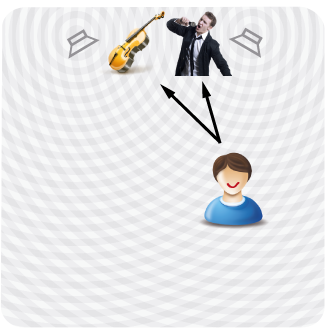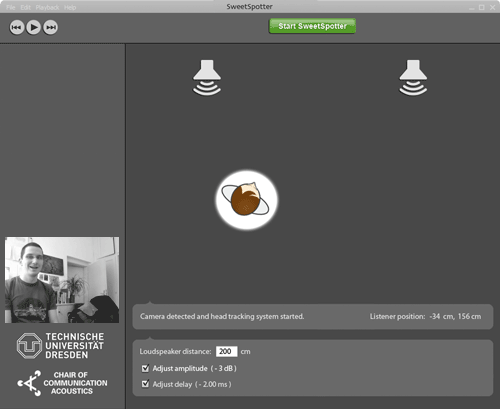 |
The spatial reproduction of sound in a conventional stereo system works in a small area which is located on the symmetry axis between the loudspeakers – the so called sweet spot. Beyond this area, the spatial perception collapses and the stereo image moves to the nearer loudspeaker since the signal arrives both louder and sooner. Finally, the stereo image is completely located in the nearer loudspeaker due to the precedence effect. Although stereophony has a long history, the listener has not yet been released from its static hearing position. |
 |
SweetSpotter demonstrates a playback system which adjusts both loudspeaker signals depending on the listener’s position in real-time. The position and orientation of the listener is tracked by a webcam and a face recognition system (head tracking). This information is used to calculate the amount of delay and amplification in the corresponding audio channels. Thereby, a correct phantom source localization over the whole off-center listening area is achieved. |
The sound localization with adaptive adjustment of the sweet spot is investigated at the Chair of Communication Acoustics, TU Dresden, Germany. This site describes the research work and software development done by Sebastian Merchel, Stephan Groth and Lars Beier.
Want to know more?
(What is the effect of asymmetric signal paths between loudspeakers and ears for off-center listening positions? What is a binaural model? ...)
Have a look at the following publications:
 |
Sebastian Merchel and Stephan Groth: Analysis and Implementation of a Stereophonic Play Back System for Adjusting the “Sweet Spot” to the Listener’s Position, Proceedings of 126th AES Convention, Munich, Germany, 2009. |
 |
Sebastian Merchel and Stephan Groth: Analysis and Implementation of a Stereophonic Play Back System for Adjusting the “Sweet Spot” to the Listener’s Position, Journal of the Audio Engineering Society, 58(10) 2010, 809–817. |
 |
Sebastian Merchel and Stephan Groth: Evaluation of a New Stereophonic Reproduction Method with Moving “Sweet Spot” Using a Binaural Localization Model, Proceedings of ISAAR Symposium, Helsingør, Denmark, 2009. |
This software is Open Source under the GNU General Public License version 3.0.
You can download the code here:
 |
SweetSpotter Source Code V1.2 - 08.06.2011 |
Experimental SweetSpotter ports to different audio programming environments:
 |
Experimental SweetSpotter implementation for Max/MSP by Maria Enge and Philipp Weiß. (It might be possible to create a VST or AU plugin of this patch using the Jamoma/Plugtastic framework. However, this is untested. Any feedback is highly appreciated.) |
 |
Experimental SweetSpotter port to PureData by Xiangqiong Zeng and Xin Yang. You will need an external head tracker, e.g. FaceOSC to get tracking information. |
Thanks to the following companies for providing their APIs:
_
 ___
___ 
See SweetSpotter tracking my face. To hear the effect download the demo above and try it yourself:

